In a startup’s first few years, growth rarely follows a neat plan. One week, engineering is scrambling to fix urgent bugs that push product launches off schedule. Marketing is chasing brand awareness campaigns, while sales is offering custom deals to close quick wins. Investors keep asking for progress reports, but the data lives in scattered spreadsheets and half-updated decks.
This chaos isn’t just stressful. It’s costly. Misaligned priorities slow product delivery, confuse customers, and make it harder to secure funding. Research shows that companies with clear, aligned goals grow revenue 58% faster than those without.
For early-stage founders, that alignment can’t wait until “we’re bigger.” The sooner you put a structure in place for setting and tracking objectives, the sooner every department starts rowing in the same direction. That’s where OKR (Objectives and Key Results) software comes in, giving you a single, shared source of truth to set priorities, track measurable outcomes, and keep every team focused on what moves the business forward.
Key Takeaways:
- Why care? OKR software keeps your startup’s chaos in check and teams rowing in the same direction.
- Adopt early: Faster growth, sharper focus, and fewer “wait… what’s the priority?” moments.
- Must-haves: Cascading goals, real-time updates, deep integrations, AI help, quick setup, room to scale.
- 2025 faves: Synergita, OKRs Tool, Weekdone, Profit.co, Perdoo, Tability.
- Startup winner: Synergita – free plan, grows with you, AI goals, easy onboarding, Jira/Slack/Teams friendly.
- Rollout hacks: Start small, link goals with context, check in weekly, integrate from day one, tweak each quarter.
- Avoid traps: Vague goals, too many objectives, rare updates, overbuilt tools you’ll never use.
What is OKR Software and Why Startups Need It Early
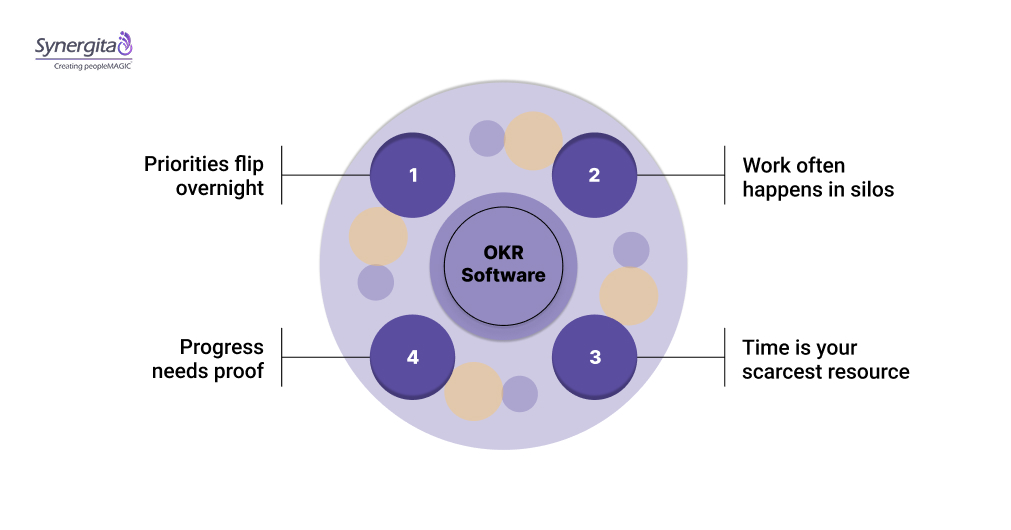
OKR software is like your startup’s GPS. It tells everyone where you are headed, how far you have come, and what needs attention right now. Instead of chasing targets in separate spreadsheets or long email threads, teams work from the same live map of priorities and progress.
For a young company, this matters because:
- Priorities flip overnight: A new competitor launches, an investor demands fresh metrics, or a customer asks for a make-or-break feature. OKR software keeps those shifts visible so teams can adapt together.
- Work often happens in silos: Sales might be closing deals that product cannot yet deliver, or marketing might be chasing leads that do not match the sales strategy. OKRs link everyone’s goals to the same outcomes.
- Time is your scarcest resource: You cannot afford three months of work on something that does not move the business forward. OKR tracking highlights misaligned efforts early.
- Progress needs proof: When investors ask “how are we tracking,” you can pull up real-time dashboards instead of piecing together updates from multiple tools.
In short, OKR software gives startups one shared scoreboard. It makes sure every feature shipped, every campaign launched, and every deal closed is part of the same bigger win.
2025’s Best Affordable OKR Software for Startups
The OKR software market is crowded, and most tools look good on a sales page. But as a founder, you are not looking for “good on paper.” You are looking for a platform your team will actually use without you having to nag them every week.
These five tools stand out for early-stage startups because they balance affordability, ease of use, and the features you genuinely need in your first few years.
A quick overview:
| Tool | Best For | Starting Price | Standout Features |
|---|---|---|---|
| Synergita OKR Starter | Testing OKRs in very small teams | Free for up to 3 users | Cascading OKRs, templates, and alignment dashboard |
| OKRs Tool | Teams of 10–25 | Free for 1–10 users;$30/month for 11+ users | Unlimited OKR cycles, hierarchical OKRs; Real-time progress tracking. |
| Weekdone | Weekly rhythm with OKR check-ins | $13.53/user/month | Weekly reports, KPI tracking, OKR hierarchy |
| Profit.co | Linking OKRs directly to tasks | $9/user/month | Task integration, KPI dashboards, customizable templates |
| Perdoo | Visualizing goal alignment | $6.50/user/month | Strategy maps, public OKRs, KPI tracking |
| Tability | AI-assisted OKR creation | $5–6/user/month | AI goal writing, custom dashboards, standups |
Here’s a breakdown of the most startup-friendly OKR tools in 2025.
1. Synergita
Best For: All team sizes who can check in regularly, with ready-to-use integrations.
Price: Free tier available for up to 3 users. Premium plans start from $3/user/month.
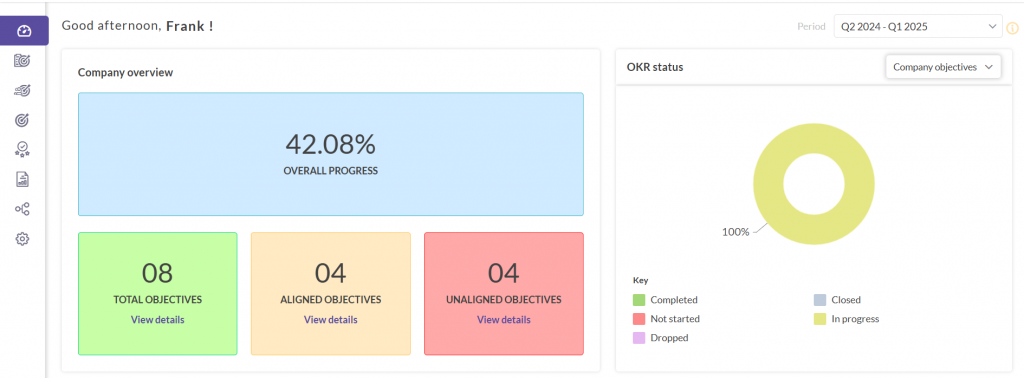
Key Features:
- Create company, team, and individual objectives
- Cascading OKR alignment so team goals map directly to company targets
- Pre-built templates for faster OKR drafting
- Reporting dashboard for quick status views
Pros:
- No upfront cost, ideal for startups in early validation phase
- Upgrade path to Lite ($3/user) or Growth ($6/user) without switching tools
- Lightweight enough for quick adoption, but structured enough to build discipline
Cons:
- Free plan limits integrations (Jira, Slack, Teams only in Growth plan)
- Reporting is basic compared to enterprise-focused platforms
2. OKRs Tool
Best For: Teams of 10–25, that get you started in seconds to set goals, track progress, and align your team.
Price: Free for 1-10 users. $30/ month for 11+ users.
Key Features:
- Unlimited OKR cycles and hierarchical OKRs
- Slack integration and weekly OKR progress report
- AI insights & recommendations with priority email support (< 2-4 hours)
- Real-time progress tracking, weekly reminders, and nudges
Pros:
- Setup is quick and intuitive, allowing goal tracking within minutes.
- Real-time tracking, weekly reminders, and AI insights help teams stay aligned without manual follow-ups.
- Slack integration, weekly reports, and priority email support (2–4 hours) ensure smooth collaboration and issue resolution.
Cons:
- The free plan is only for up to 10 users, which may not be ideal for slightly larger teams.
- Teams may need time to understand and trust AI-generated recommendations.
3. Weekdone
Best For: Teams that thrive on a consistent, weekly update cadence
Price: $13.53/user/month
Key Features:
- Weekly OKR check-ins that keep goals top of mind
- Hierarchical OKR tree to visualize company-wide alignment
- KPI tracking alongside OKRs
- Exportable, customizable progress reports
Pros:
- Keeps teams engaged with lightweight weekly updates
- Easy to onboard for non-technical users
- Strong alignment visibility for small to mid-sized teams
Cons:
- Pricing can be high for very early-stage teams
- Limited scalability for complex, multi-team structures
4. Profit.co
Best For: Startups that want OKRs tightly integrated with daily task management
Price: $9/user/month (Growth plan)
Key Features:
- Task linkage so every initiative maps to a key result
- Customizable OKR templates for different departments
- KPI dashboards for data-driven tracking
- Built-in reporting for performance reviews
Pros:
- Unites strategic OKRs with operational task execution
- Flexible templates for marketing, sales, product, and engineering
- Strong reporting for investor updates or board meetings
Cons:
- Can feel feature-heavy for small teams with limited admin capacity
- UI may require initial training for optimal use
5. Perdoo
Best For: Startups that value visualizing strategy and goal alignment in one view
Price: $6.50/user/month
Key Features:
- Strategy maps to show how objectives connect across the company
- Public OKRs for transparent goal sharing
- KPI tracking for measurable progress
- Custom dashboards to focus on the most relevant data
Pros:
- Excellent for making goal alignment visible to all employees
- Affordable entry point with robust visualization tools
- Good balance between structure and flexibility
Cons:
- Fewer collaboration tools compared to all-in-one work platforms
- Lacks integrated performance management features
6. Tability
Best For: Teams looking for AI support in OKR drafting and updates
Price: $5–6/user/month (Basic), $8–10/user/month (Premium)
Key Features:
- AI-assisted OKR creation to speed up planning cycles
- Custom dashboards tailored to different roles
- Weekly standup check-ins to maintain momentum
- Strategy mapping without heavy hierarchy requirements
Pros:
- Cuts down OKR setup time with AI drafting
- Keeps updates light and frequent
- Flexible enough for non-traditional OKR structures
Cons:
- Reporting is less detailed than in enterprise tools
- It may feel too lightweight for teams with complex governance needs.
While these platforms each bring unique strengths to the table, choosing the right OKR software for your startup isn’t about picking the one with the flashiest feature set. The best tools are those that help teams stay aligned, track progress effortlessly, and avoid creating more administrative overhead than actual results.
In the early stages of a startup, you rarely have the availability or a dedicated OKR manager to babysit updates or train teams on complex systems. What matters most is clarity, speed, and adaptability: a tool that works right out of the box, keeps everyone moving in the same direction, and scales alongside your growth.
Here’s what to focus on when evaluating OKR software for your startup:
Key Features to Look for in OKR Software for Startups
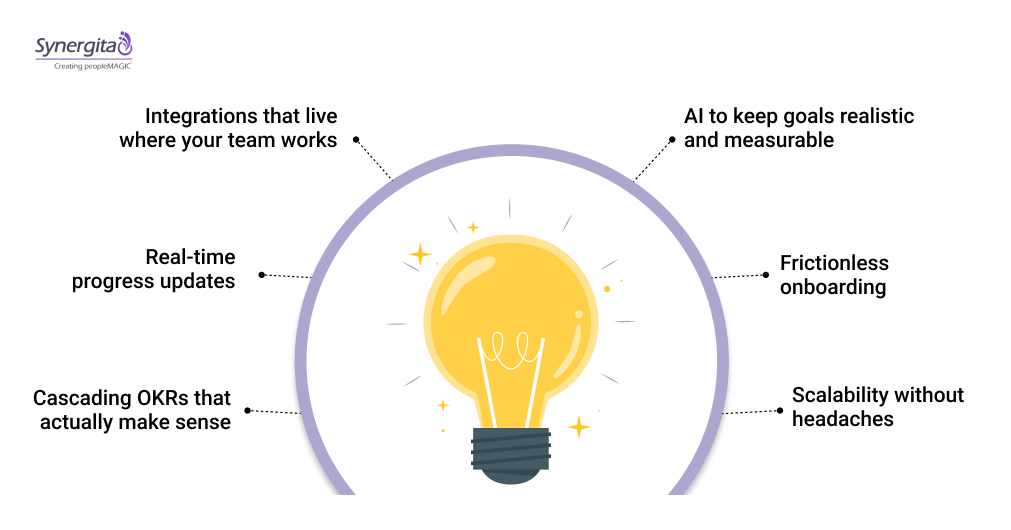
The right OKR tool for a startup is not the one with the longest feature list. It is the one that keeps everyone moving in the same direction without creating more admin work than actual progress. In the early stages, you do not have the luxury of a full-time OKR manager. The software needs to be self-explanatory, quick to set up, and flexible enough to grow with you.
Here is what matters most when you are choosing:
1. Cascading OKRs that actually make sense
It is not enough for an OKR tool to let you set goals at multiple levels. The real magic is when a company-level objective like “Grow MRR by 30%” can be directly connected to marketing’s lead-gen targets, sales’ close rates, and product’s release timelines. That way, no one is working on “nice-to-have” projects while the main goal suffers.
2. Real-time progress updates
Startups cannot wait for end-of-month reports to discover that a key result is slipping. Your OKR tool should update automatically as work gets done, showing exactly where things stand. If a conversion rate starts dropping mid-quarter, you see it immediately and can react before it tanks your numbers.
3. Integrations that live where your team works
Your engineering team lives in Jira. Marketing is in HubSpot. Customer success spends the day in Slack or Teams. If your OKR tool does not pull updates from these systems automatically, it becomes just another tab no one remembers to check. Look for integrations that keep OKRs part of daily workflows, not an isolated island.
4. AI to keep goals realistic and measurable
Early teams often set goals that are either too vague or too ambitious. AI-assisted goal setting can analyze your historical data and suggest targets that are actually achievable. It can also flag when a key result is missing a measurable metric, saving you from chasing fuzzy outcomes.
5. Frictionless onboarding
If it takes two weeks of training to get your team to use the tool, it is the wrong tool. You want a setup where a founder can create company-level OKRs in an afternoon and teams can start adding their own the same day.
6. Scalability without headaches
You might start with five people and be at fifty by next year. Your OKR tool should scale smoothly so you are not forced into a painful migration just when you are hitting your stride. Check if the platform offers the next tier of features you will need before you get there.
When you have these features in place, OKR software stops being a reporting exercise and becomes the operating system for your startup’s growth.
Benefits of Adopting OKR Software Early in a Startup
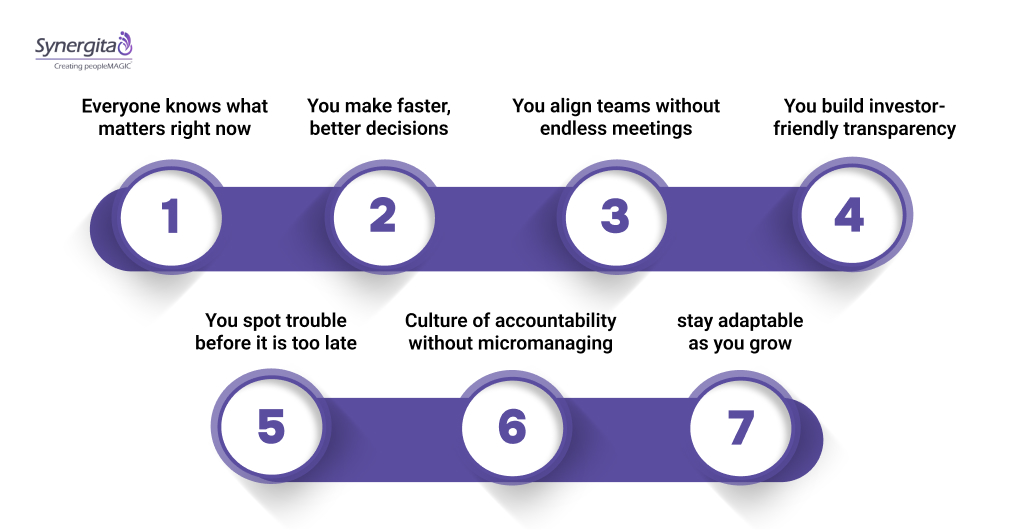
The early days of a startup are exciting and messy. You are experimenting with your product, chasing customers, keeping investors happy, and firefighting daily issues. In the middle of all this, it is dangerously easy for teams to drift in different directions. That is where adopting OKR software early can make all the difference.
Here is what it actually does for you when you start using it before the chaos gets out of hand:
1. Everyone knows what matters right now
In a startup, priorities can change by the hour. An investor call might suddenly push revenue growth to the top of the list. A competitor’s new feature might shift focus to speed-to-market. With OKR software, these changes are visible across the company in real time. No more “Wait, when did we decide this was the priority?” moments.
2. You make faster, better decisions
When you can see exactly how each key result is performing, you can decide in minutes whether to double down or change course. Maybe your conversion rate is better than expected, you might decide to increase ad spend immediately. Maybe your feature adoption is slow, you might pause new development and focus on fixing onboarding. The point is, decisions are based on live data, not gut feelings from last month’s numbers.
3. You align teams without endless meetings
A well-set OKR in the tool does the heavy lifting of alignment. Sales does not need to “sync” with products three times a week to check if priorities match. Marketing can see if product delays mean campaign dates should shift. Everyone has visibility without clogging the calendar with status updates.
4. You build investor-friendly transparency
Early-stage investors want to know exactly how their money is being used to drive results. Instead of sending them a messy spreadsheet or a hastily prepared deck, you can share clean dashboards showing progress toward agreed goals. This makes funding conversations smoother and positions you as a founder who has control over the business.
5. You spot trouble before it is too late
Without OKR tracking, you often find out something is off only at the end of the quarter. By then, fixing it means sacrificing the next quarter too. With real-time visibility, you can intervene as soon as a metric slips. This could mean reallocating resources, adjusting timelines, or changing strategy entirely; all before major damage is done.
6. You create a culture of accountability without micromanaging
Because progress is visible to everyone, people naturally take ownership. There is less chasing, less “Did you finish that?” and more “Here’s where we are, and here’s what I am doing to move us forward.” That is powerful in a startup where you cannot afford dead weight.
7. You stay adaptable as you grow
Startups often go through rapid headcount jumps. Without a system, every new hire means re-explaining priorities from scratch. With OKR software, they can log in on day one and instantly see what the company is trying to achieve and how their role fits in.
Adopting OKR software early is like installing guardrails on a mountain road. It does not stop you from moving fast, but it keeps you from veering off the cliff when things get hectic.
How to Choose the Right Affordable OKR Tool for Your Stage
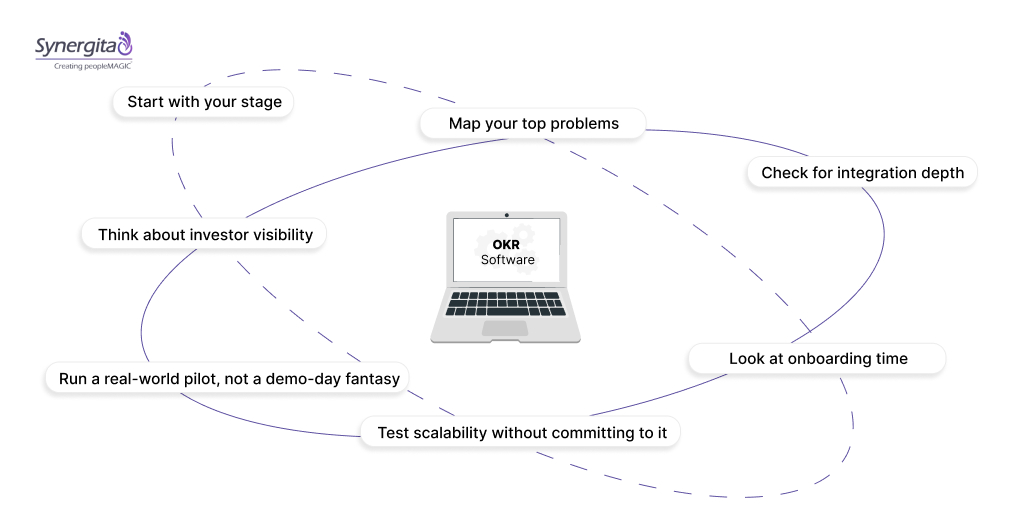
Picking OKR software as a startup is not about finding the tool with the longest feature list. It is about finding one that fits your current stage, solves your most urgent problems, and will not become a burden in three months. The wrong choice can either slow you down with unnecessary complexity or force you into a painful migration just when you start gaining traction.
Here is how to think about it if you are in your first few years of growth:
1. Start with your stage, not someone else’s wishlist
A pre-seed or seed-stage startup does not need the same OKR platform as a 500-person scale-up. If you are under ten people, you probably need a tool that is dead simple, quick to set up, and has just enough features to keep everyone aligned. Series A or later? You might need more advanced integrations, better reporting, and role-based permissions. Match the tool to where you are now, not where you think you might be in five years.
2. Map your top problems to must-have features
Are teams working in silos? Look for strong cascading OKR capabilities and transparent dashboards. Struggling to keep up with shifting priorities? Real-time updates and easy editing are key. Wasting time on manual updates? Prioritize integrations with your existing stack. Let your biggest pain points lead the selection process.
3. Check for integration depth, not just logos on a website
Every OKR tool will claim it “integrates” with Slack, Jira, or HubSpot. The question is, how? Does the integration just send notifications, or can it actually pull data to update key results automatically? True integration means your team does not need to double-enter progress.
4. Look at onboarding time like it is a dealbreaker
In a startup, you do not have weeks to train people. Ask the vendor for a realistic setup time. Can your company-level OKRs be live within a day? Can a non-technical team member update their progress without calling for help? If not, you will waste more time managing the tool than using it.
5. Test scalability without committing to it
You might be small now, but growth can be fast. Check if the tool offers affordable mid-tier plans with the features you will need when you double or triple your headcount. Upgrading within the same platform is far easier than migrating to a new one when you are scaling fast.
6. Run a real-world pilot, not a demo-day fantasy
Instead of relying on a sales demo, set up a one-month trial with actual company OKRs. Involve multiple teams and see how often they log in, how easily they can update progress, and whether the tool genuinely reduces confusion. If adoption drops after week one, that is a red flag.
7. Think about investor visibility from day one
Even if you do not have formal board reporting yet, choose a platform that can generate clean, visual progress reports. When the time comes to show traction, you will have polished data at your fingertips instead of scrambling to assemble numbers from scattered sources.
Choosing the right OKR tool for your stage is less about “Which one is the best?” and more about “Which one will we actually use every week without it becoming a chore?” The tool that helps your five-person team align today and can grow into your 50-person team tomorrow is the one worth betting on.
How to Successfully Roll Out OKR Software in a Startup
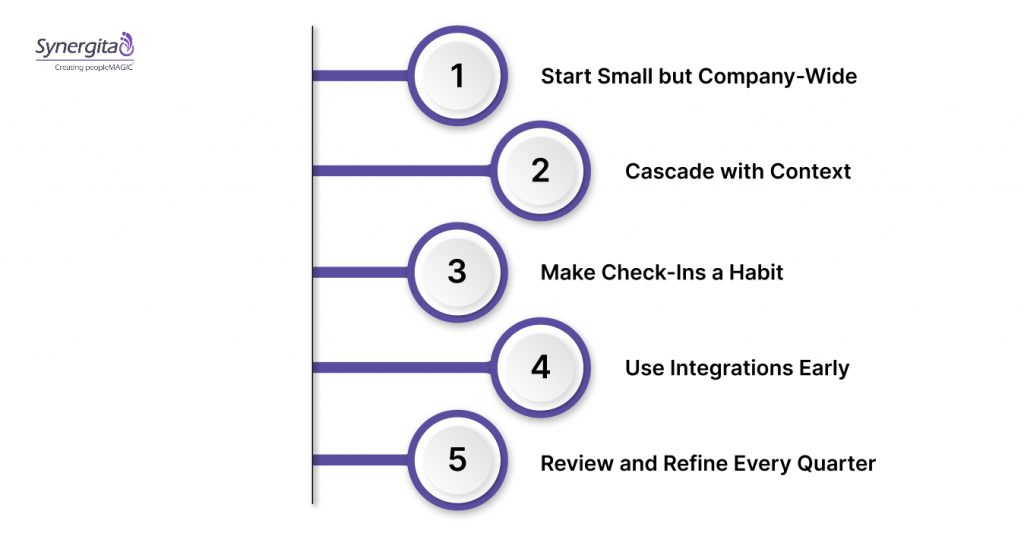
Buying an OKR tool is the easy part. Making it a living part of your startup’s DNA is where the real work begins. In early-stage companies, the risk is not that OKRs fail; it’s that they turn into a once-a-quarter form-filling exercise nobody looks at. A successful rollout means weaving OKRs into the way your team thinks, decides, and acts.
Step 1: Start Small but Company-Wide
In your first quarter, resist the temptation to over-engineer the system. Set no more than three to five company objectives for the entire business, each with measurable key results. For example:
- Objective: Increase Monthly Recurring Revenue (MRR) by 25%.
- Key Results: Close 15 new mid-tier accounts; Reduce churn from 6% to 4%.
This gives everyone a shared direction without overwhelming teams with dozens of unrelated targets. In one seed-stage SaaS startup we worked with, keeping initial OKRs simply helped the founder’s five-person team hit two major product milestones in 60 days; something they had struggled to do in the previous six months.
Step 2: Cascade with Context
Cascading OKRs should not just be a top-down copy-paste exercise. Each team needs to see why their goals matter. If your company objective is “Improve customer retention by 15%,” your product team’s OKR might be “Reduce critical bugs by 30%,” while customer success focuses on “Increase average NPS from 45 to 60.”
The linkage should be visible inside your OKR software so that, in a single dashboard, you can trace a company goal directly to the tasks being executed in Jira or Trello. This transparency keeps teams from chasing unrelated wins.
Step 3: Make Check-Ins a Habit
The biggest reason OKRs fail in startups is the “set and forget” syndrome. Weekly or biweekly check-ins prevent nasty surprises at the end of the quarter. Keep these updates lightweight, 15 minutes per team and focused on:
- Progress against each key result.
- Roadblocks and what’s needed to remove them.
- Adjustments based on new priorities.
When a fintech startup in its Series A stage switched from monthly updates to weekly 10-minute check-ins via Slack integration, on-track key results jumped from 42% to 68% in one quarter.
Step 4: Use Integrations Early
Startups thrive on speed, so don’t make people log into “yet another tool” to update OKRs. Set up Slack, Teams, or Jira integrations on day one. That way, progress updates happen automatically when tasks are completed, and reminders pop up where work is already happening.
This prevents the tool from becoming a disconnected tracker; it becomes part of daily work. For example, when your sales team closes a deal in HubSpot, the linked key result in your OKR tool should update instantly.
Step 5: Review and Refine Every Quarter
Your first OKR cycle will not be perfect, and that’s the point. At the end of each quarter:
- Review completion rates and whether hitting the KRs moved the right business metrics.
- Identify where objectives were too vague or too easy.
- Adjust for the next quarter based on learnings and any shifts in market conditions.
One early-stage e-commerce brand learned that its Q1 OKR “Increase Instagram engagement” wasn’t directly impacting sales. By Q2, they reframed it into “Increase website traffic from Instagram by 20%,” which directly tied to revenue and converted better.
Why Synergita is a Strong Choice for Startups
For startups, the best OKR platform is the one you can start using immediately, without lengthy onboarding or costly consulting. Synergita’s OKR Starter plan was designed with this in mind, giving small teams the same goal alignment and tracking capabilities that larger companies rely on, without the overhead.
What sets Synergita apart is how it grows with your business. The free Starter plan offers enough structure to build OKR discipline from day one, while Lite and Growth plans add advanced capabilities like cascading OKRs, AI goal recommendations, and Jira, Slack, or Microsoft Teams integration. This means you can begin with the essentials and add complexity only when your operations require it.
Key advantages for startups:
- Quick setup and self-onboarding: Launch your OKR program in hours, not weeks.
- Cascading OKRs: Ensure every department’s goals connect directly to company-level objectives, making investor updates easier and more transparent.
- AI-powered OKR Buddy: Get recommendations for measurable, realistic goals based on industry benchmarks and past results.
- Tool integrations: Sync product sprints from Jira, track marketing campaigns in Slack, and keep customer success goals visible in Teams without switching platforms.
- Scalability without migration: Move from a 3-user setup to a multi-department structure without changing systems or re-training your team.
For a startup juggling limited resources, Synergita offers a practical path: start free, prove the value of OKRs, and expand your capabilities when the business is ready. Start your free trial!
Final Take
For a startup, clarity and speed can make the difference between scaling and stalling. Synergita’s OKR Starter plan helps you set priorities that everyone can see, track progress as it happens, and keep every department moving toward the same growth targets. You can begin with the essentials, expand only when needed, and stay focused on building momentum.
Book a demo today and see how Synergita can keep your goals and your growth on track.
FAQs
Q. What is OKR software, and how does it work?
A: OKR software is a platform that helps businesses define clear objectives and measurable key results, breaking company goals into team and individual tasks. Through dashboards, real-time tracking, and integrations with tools like Slack or Jira, it provides visibility, alignment, and accountability, ensuring everyone understands how their work drives organizational success.
Q. What is the best OKR software for small businesses?
A: For small businesses, the best OKR tools are simple, affordable, and quick to implement. Synergita, Weekdone, and Perdoo are ideal—they allow teams to set, track, and update OKRs easily without extensive admin overhead. These platforms foster alignment, accountability, and measurable progress even in lean teams.
Q. What is the best OKR software in India?
A: In India, startups and SMEs can use global platforms like Profit.co or Tability, but India-based Synergita stands out with local support, competitive pricing, and integrations suited for distributed teams. These tools simplify OKR tracking, provide visibility across departments, and help ensure that even geographically spread teams stay aligned.
Q. Is there an easy-to-use OKR tool for my team and me?
Yes. Tools like Tability and Weekdone are designed for simplicity, helping teams start tracking OKRs immediately without lengthy training. They offer intuitive dashboards, lightweight reporting, and automated reminders, making them perfect for startups or small teams that want results without the overhead of complex enterprise software.
Q. What is the best free tool for small business owners to manage their entire business from one place?
A: While no single free tool covers every business need, Synergita’s free plan is excellent for OKRs, providing goal-setting, dashboards, and basic reporting for up to three users. For additional task or project management, combining it with free tools like Trello or ClickUp creates a more complete workflow.



